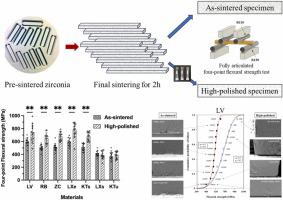当前位置:
X-MOL 学术
›
Dent. Mater.
›
论文详情
Our official English website, www.x-mol.net, welcomes your feedback! (Note: you will need to create a separate account there.)
Strength-limiting damage and defects of dental CAD/CAM full-contour zirconia ceramics
Dental Materials ( IF 5 ) Pub Date : 2024-02-19 , DOI: 10.1016/j.dental.2024.02.003 Young-Seok Kwon , Jae-Heon Kim , Hwalim Lee , Susanne S. Scherrer , Hae-Hyoung Lee
Dental Materials ( IF 5 ) Pub Date : 2024-02-19 , DOI: 10.1016/j.dental.2024.02.003 Young-Seok Kwon , Jae-Heon Kim , Hwalim Lee , Susanne S. Scherrer , Hae-Hyoung Lee

|
This study aimed to compare the four-point flexural strength of CAM-milled and sintered (as-sintered, AS) specimens with those of high-polished (HP) specimens using chairside polishing systems to simulate clinical surface conditions. Seven full-contour zirconia CAM/CAM blanks with various yttria contents (3, 4, 5 mol%) including three high-translucent groups (5Y) were selected to prepare flexural specimens. The bend bar specimens (2.0 × 4.0 × 25.0 mm) were fabricated by using STL file and dental CAM machine with the respective zirconia blanks (98 mm and 10–14 mm in height). Twelve bar specimens were machined from one zirconia puck and a total of 24 specimens were prepared from each group. The pre-sintered bar specimens were sintered by using a dental zirconia furnace at 1530–1550 °C for 2 h according to the instructions. All sintered specimens were divided into two groups: as-sintered (AS) group and high-polished (HP) groups (n = 12). HP groups were subjected to polishing one surface of specimens using a three-step polishing system and finally finished with diamond polishing. After cleaning and drying, the flexural strength of all specimens was determined by a fully articulating four-point flexure fixture consisting of a 1/4-point test configuration with an inner/outer span of 10/20 mm. Statistical differences between AS and HP groups were conducted with Weibull analysis. The fractured surfaces of zirconia specimens were observed using a field emission SEM and EDS to detect failure origins. The mean AS flexural strength values were significantly lower than those of HP counterparts. However, Weibull moduli expressing the reliability of HP groups were generally decreased although not significantly in comparison to their AS. The fracture of the AS specimens mostly originated from extrinsic CAM-milling defects, while the HP specimens were fractured from intrinsic subsurface or volume defects including pores, large grain clusters, inclusions, and corner-located critical flaws. Two high-translucent (5Y) zirconia groups were not affected in their strength and reliability after polishing, whereas one 5Y zirconia significantly increased its strength but significantly lowered its reliability. The extrinsic and intrinsic strength-limiting defects should be considered in evaluating the flexural strength and reliability of dental CAD/CAM zirconia ceramics for full-contour restorations. For the materials tested in this study, more optimized processing of blanks and milling protocols of pre-sintered zirconia blanks should be developed including post-sintering surface finishing to reduce the flaw population regulating strength and reliability which will affect the survivability of dental zirconia prostheses.
中文翻译:

牙科 CAD/CAM 全轮廓氧化锆陶瓷的强度限制损伤和缺陷
本研究旨在比较 CAM 铣削和烧结(AS-sintered,AS)样本与使用椅旁抛光系统模拟临床表面条件的高抛光(HP)样本的四点弯曲强度。选择七种不同氧化钇含量(3、4、5 mol%)的全轮廓氧化锆CAM/CAM毛坯,其中包括三个高透光组(5Y)来制备弯曲试样。弯杆样本(2.0 × 4.0 × 25.0 mm)是通过使用 STL 文件和牙科 CAM 机器以及相应的氧化锆毛坯(高度为 98 mm 和 10-14 mm)来制造的。由一个氧化锆圆盘加工出 12 个棒材样本,每组总共制备 24 个样本。根据说明,使用牙科氧化锆炉在 1530-1550 °C 下将预烧结棒样品烧结 2 小时。所有烧结样品分为两组:烧结态(AS)组和高抛光(HP)组(n = 12)。 HP 组使用三步抛光系统对样品的一个表面进行抛光,最后用金刚石抛光完成。清洁和干燥后,所有样本的弯曲强度由全铰接四点弯曲夹具测定,该夹具由内/外跨度为 10/20 mm 的 1/4 点测试配置组成。 AS组和HP组之间的统计差异采用Weibull分析进行。使用场发射 SEM 和 EDS 观察氧化锆样品的断裂表面,以检测失效源。 AS 平均弯曲强度值明显低于 HP 同类产品。然而,表达 HP 组可靠性的威布尔模量普遍下降,尽管与 AS 相比并不显着。 AS 试样的断裂主要源于外在的 CAM 铣削缺陷,而 HP 试样的断裂则源于内在的次表面或体积缺陷,包括孔隙、大晶粒簇、夹杂物和位于角部的关键缺陷。抛光后,两组高透光性(5Y)氧化锆组的强度和可靠性没有受到影响,而一组5Y氧化锆的强度显着提高,但可靠性显着降低。在评估用于全轮廓修复体的牙科 CAD/CAM 氧化锆陶瓷的弯曲强度和可靠性时,应考虑外在和内在的强度限制缺陷。对于本研究中测试的材料,应开发更优化的毛坯加工和预烧结氧化锆毛坯的铣削方案,包括烧结后表面精加工,以减少调节强度和可靠性的缺陷数量,这将影响牙科氧化锆修复体的耐用性。
更新日期:2024-02-19
中文翻译:

牙科 CAD/CAM 全轮廓氧化锆陶瓷的强度限制损伤和缺陷
本研究旨在比较 CAM 铣削和烧结(AS-sintered,AS)样本与使用椅旁抛光系统模拟临床表面条件的高抛光(HP)样本的四点弯曲强度。选择七种不同氧化钇含量(3、4、5 mol%)的全轮廓氧化锆CAM/CAM毛坯,其中包括三个高透光组(5Y)来制备弯曲试样。弯杆样本(2.0 × 4.0 × 25.0 mm)是通过使用 STL 文件和牙科 CAM 机器以及相应的氧化锆毛坯(高度为 98 mm 和 10-14 mm)来制造的。由一个氧化锆圆盘加工出 12 个棒材样本,每组总共制备 24 个样本。根据说明,使用牙科氧化锆炉在 1530-1550 °C 下将预烧结棒样品烧结 2 小时。所有烧结样品分为两组:烧结态(AS)组和高抛光(HP)组(n = 12)。 HP 组使用三步抛光系统对样品的一个表面进行抛光,最后用金刚石抛光完成。清洁和干燥后,所有样本的弯曲强度由全铰接四点弯曲夹具测定,该夹具由内/外跨度为 10/20 mm 的 1/4 点测试配置组成。 AS组和HP组之间的统计差异采用Weibull分析进行。使用场发射 SEM 和 EDS 观察氧化锆样品的断裂表面,以检测失效源。 AS 平均弯曲强度值明显低于 HP 同类产品。然而,表达 HP 组可靠性的威布尔模量普遍下降,尽管与 AS 相比并不显着。 AS 试样的断裂主要源于外在的 CAM 铣削缺陷,而 HP 试样的断裂则源于内在的次表面或体积缺陷,包括孔隙、大晶粒簇、夹杂物和位于角部的关键缺陷。抛光后,两组高透光性(5Y)氧化锆组的强度和可靠性没有受到影响,而一组5Y氧化锆的强度显着提高,但可靠性显着降低。在评估用于全轮廓修复体的牙科 CAD/CAM 氧化锆陶瓷的弯曲强度和可靠性时,应考虑外在和内在的强度限制缺陷。对于本研究中测试的材料,应开发更优化的毛坯加工和预烧结氧化锆毛坯的铣削方案,包括烧结后表面精加工,以减少调节强度和可靠性的缺陷数量,这将影响牙科氧化锆修复体的耐用性。



























 京公网安备 11010802027423号
京公网安备 11010802027423号